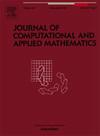A combined Method Of Lines and Orthogonal Collocation with Second kind Chebyshev nodes for convection–diffusion–reaction equation with Danckwerts Conditions
IF 2.1
2区 数学
Q1 MATHEMATICS, APPLIED
Journal of Computational and Applied Mathematics
Pub Date : 2025-05-28
DOI:10.1016/j.cam.2025.116731
引用次数: 0
Abstract
We analyze and develop two numerical methods to solve the convection–diffusion–reaction equation with Danckwerts boundary conditions. One of the methods is an approach based on the method of lines using spatial discretization by orthogonal collocation. While this method has been applied to other equations, it has not been previously studied for this particular case. Furthermore, the convergence of the method is demonstrated for various values of the Péclet and Damköhler numbers. We also describe the implementation of a weighted residual method by orthogonal collocation method, using Lagrange polynomials and Chebyshev nodes of the second kind to solve the same problem. Both methods are presented in matrix form to facilitate its implementation in Matlab. Finally, we compare the results with both the analytical solution and those from a previous conventional method of lines discretization based on finite differences, implemented by the authors. The computed errors demonstrate that the adapted method of lines with orthogonal collocation yields a more accurate overall approximation than the alternative approaches.
具有Danckwerts条件的对流-扩散-反应方程的第二类Chebyshev节点线与正交配点法
本文分析并发展了两种求解具有Danckwerts边界条件的对流-扩散-反应方程的数值方法。其中一种方法是基于正交配置空间离散化的直线方法。虽然这种方法已经应用于其他方程,但以前还没有研究过这种特殊情况。此外,还证明了该方法对psamclet和Damköhler数的不同值具有收敛性。利用拉格朗日多项式和第二类切比雪夫节点,用正交配点法实现了加权残差法。为了便于在Matlab中实现,这两种方法都以矩阵形式给出。最后,我们将结果与解析解和由作者实现的基于有限差分的传统线离散化方法的结果进行了比较。计算误差表明,与其他方法相比,正交配线法得到了更精确的整体逼近。
本文章由计算机程序翻译,如有差异,请以英文原文为准。
求助全文
约1分钟内获得全文
求助全文
来源期刊
CiteScore
5.40
自引率
4.20%
发文量
437
审稿时长
3.0 months
期刊介绍:
The Journal of Computational and Applied Mathematics publishes original papers of high scientific value in all areas of computational and applied mathematics. The main interest of the Journal is in papers that describe and analyze new computational techniques for solving scientific or engineering problems. Also the improved analysis, including the effectiveness and applicability, of existing methods and algorithms is of importance. The computational efficiency (e.g. the convergence, stability, accuracy, ...) should be proved and illustrated by nontrivial numerical examples. Papers describing only variants of existing methods, without adding significant new computational properties are not of interest.
The audience consists of: applied mathematicians, numerical analysts, computational scientists and engineers.

 求助内容:
求助内容: 应助结果提醒方式:
应助结果提醒方式:


